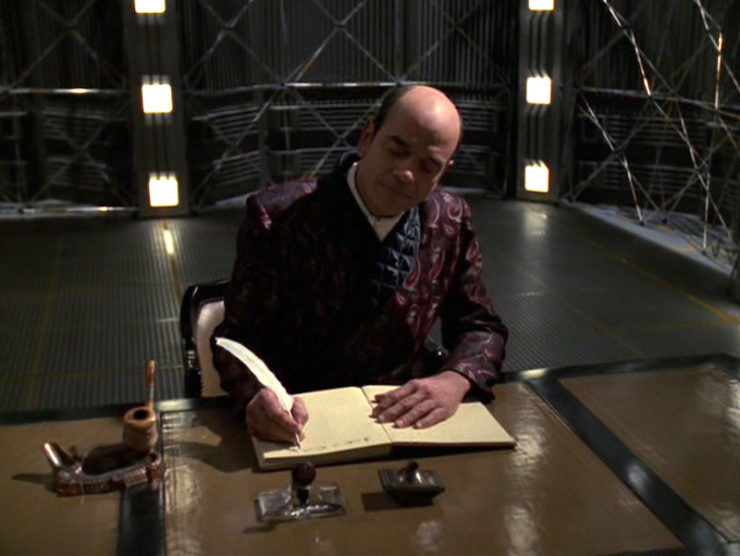“Author, Author”
Written by Brannon Braga and Phyllis Strong & Michael Sussman
Directed by David Livingston
Season 7, Episode 20
Production episode 266
Original air date: April 18, 2001
Stardate: 54732.3
Captain’s log. The EMH has written a holo-novel called Photons, Be Free. Meanwhile, Project: Pathfinder, based on an idea from Seven and Kim, has found a way to do real-time communication for a limited time once per day. During the first talk, with Barclay and Owen, they get to see a real-time image of Earth.
Each crewperson gets a window of time to speak to someone in the Alpha Quadrant. Neelix provides a bag full of numbered chips—the EMH is lucky enough to get #1. While Paris assumes he’s going to talk to either Barclay or Zimmerman, he is, in fact, talking to Ardon Broht, a Bolian from the Broht & Forrester holo-novel publisher. They’re all set to distribute Photons, Be Free, though the EMH says he needs to do one more pass on it.
Buy the Book
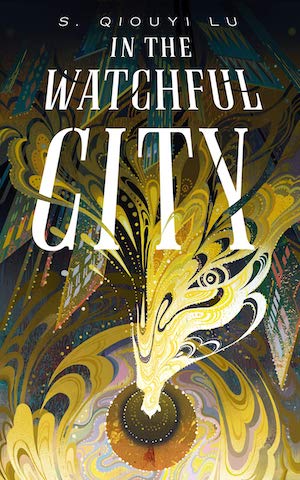

In the Watchful City
When he relieves Paris in sickbay, the EMH tells the pilot about Photons, Be Free, and also expresses a concern that he may not be able to do the revisions in time for the publisher’s deadline. Paris offers to try the program out, as a fellow holo-novelist, and the EMH agrees.
Paris is appalled when he actually goes through the program. For starters, the introduction is a horse-choking nine minutes long. The story appears to be autobiographical—the holodeck player gets to be the Emergency Medical Hologram on the U.S.S. Vortex, a ship trapped on the far side of the galaxy under Captain Jenkins, who looks a lot like Janeway only with darker hair. The EMH is treated with disdain by the organic crew. Lieutenant Marseilles, who looks a lot like Paris only with a mustache, is brought in with a mild concussion. The Bajoran first officer, Katanay, who looks a lot like Chakotay only with a ponytail and a different tattoo, insists that Marseilles be treated first, even though there’s another crewperson who needs immediate surgery. Jenkins settles the dispute by shooting the crewperson who needs surgery, thus allowing the EMH to work on Marseilles.
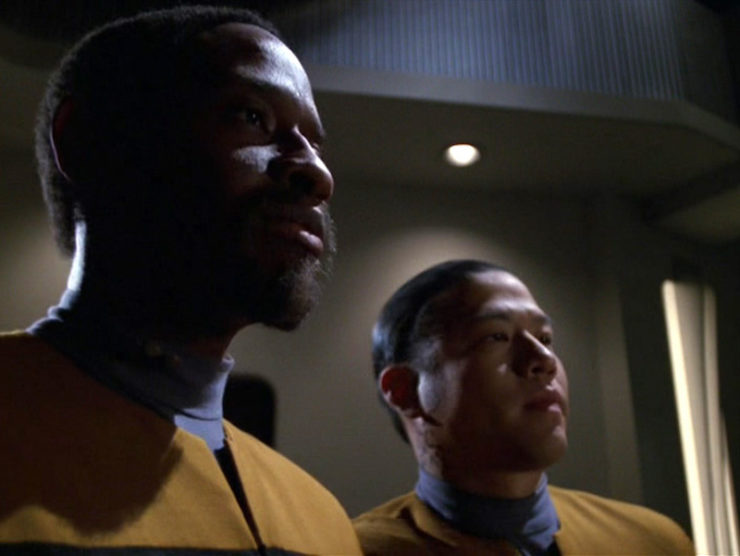
Paris is not happy about the program, and several other folks try it out, including Kim, Torres, Neelix, and Janeway. We also get to see the security chief Tulak, who looks a lot like Tuvok only human and with a goatee, the chief engineer Torrey, who looks a lot like Torres only human, and the ops officer Ensign Kymble, who looks a lot like Kim only Trill. When Janeway goes through the holo-novel, she’s seriously pissed, and summons the EMH for a talking-to. The doctor insists that the characters aren’t the same as the Voyager crew, but the similarities are a little too close.
The EMH reveals the true reason for writing this particular novel: when he learned that the other EMH Mark 1s were reassigned to menial tasks like scrubbing and mining. He wants to draw attention to how his fellow holograms are being mistreated. However, the rest of the crew is not happy with how they’ve been portrayed. The EMH insists that the resemblances are superficial and nothing for the crew to be concerned with.
Later, the EMH goes to tinker with the program, only to find that Paris has replaced it with one of his own: one in which the player is the medic assigned to work with the EMH on the U.S.S. Voyeur. Said EMH has a combover and is incredibly sleazy. The EMH is outraged that Paris overwrote his novel, but Paris assures him that he saved Photons, Be Free. He also uses the same argument that the EMH used about how they aren’t really the same characters.
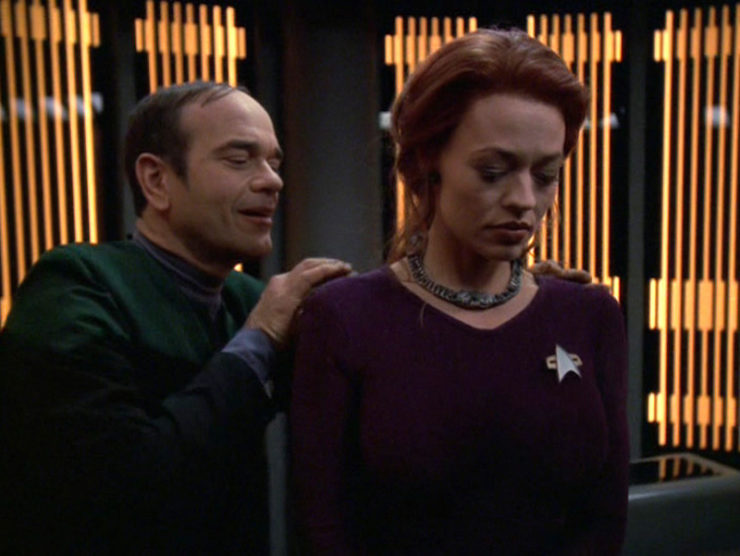
Between that, and Neelix playing devil’s advocate and suggesting that the EMH shouldn’t let a few disgruntled crewmates stop him from getting his message out (prompting the doctor to remind Neelix that these are his friends), the EMH finally decides to revise the novel.
Unfortunately, Photons, Be Free has already been published—Broht & Forester went ahead and put out the first draft that the EMH had sent. Voyager finds this out when Owen and Barclay inform them over the new link.
Speaking of that link, Kim is able to talk to his parents in time for his mother’s birthday, Torres has a virtual reunion with her father, and Seven speaks to her paternal aunt, who has many fond memories of little Annika.
When queried as to why he went against the express wishes of the author by publishing the first draft, Broht points out that the author is a hologram who has no rights, so Broht can do what he wants. Janeway challenges this, and an arbitrator is summoned. Over the link (and only for about thirty minutes a day or so), Tuvok argues for the EMH’s rights as an artist. Broht in turn argues that he’s not a sentient being, merely a program. Several strategies are considered and rejected by the Voyager crew: one is that Starfleet can claim that the novel reveals classified information, but that won’t mitigate the risk factor of ruining the reputation of the Voyager crew in the eyes of the general public. Janeway suggests another strategy: testifying to the EMH’s individuality. This includes things like the Emergency Command Hologram, his lessons to Seven, and his disobeying Janeway’s orders when he helped the Hirogen holograms.
The arbitrator isn’t willing to concede that the EMH is a sentient being—but he does agree that he can be considered an artist under the Twelfth Guarantee, which defines an artist as a person who creates an original artistic work. The EMH has done so, and therefore should have the same rights that any artist in the Federation enjoys. Broht is ordered to recall every copy of Photons, Be Free. The EMH is not entirely happy, as thousands of copies have already been distributed, but he’s still going to revise it and find another publisher.
Four months later, in a dilithium processing facility, one former Mark 1 EMH talks to another and recommends this new book, Photons, Be Free…
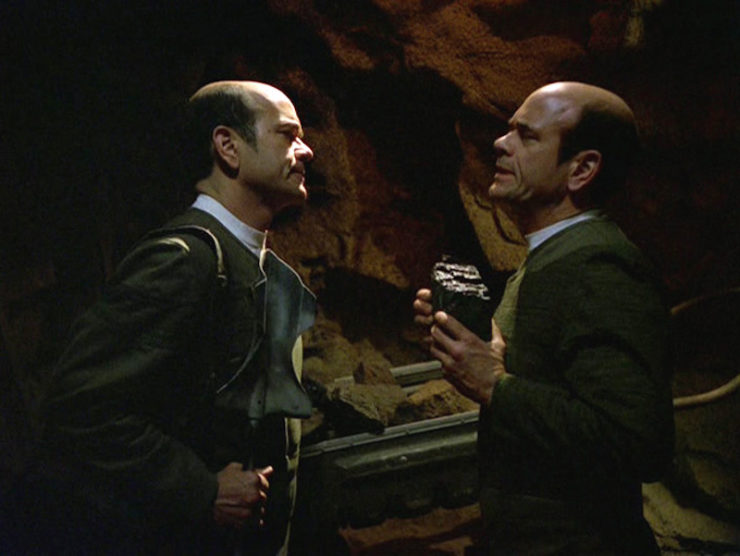
Can’t we just reverse the polarity? Apparently, if you bounce a tachyon beam off a quantum singularity, you can instantly communicate over 30,000+ light-years. Who knew?
There’s coffee in that nebula! The look of quiet fury on Janeway’s face when she finishes Photons, Be Free and summons the EMH for a spanking is just epic. But once it becomes clear that his rights have been violated, she’s in with both feet defending him.
Mr. Vulcan. For the second time (the first being “Death Wish“), Tuvok gets to play lawyer, serving as the EMH’s advocate during the hearing.
Half and half. The single greatest (and funniest) moment in the entire episode is when Torres is doing the holo-novel and Lieutenant Marseilles walks into sickbay, and she gets a look at her husband’s face with a mustache on it, and she cracks an amused smile for just a second before getting back into character. It’s a beautiful moment, played perfectly by Roxann Dawson and director David Livingston.
Torres also speaks to her father for the first time since he walked out on her and her mother. It’s a magnificent combination of awkward and sweet.
Everybody comes to Neelix’s. Neelix is the only one who admits to liking Photons, Be Free. Of course, he’s also (a) trying to get the EMH to stop sulking and maybe fix the program so it doesn’t piss everyone off, and (b) hoping to put a proposal for a cookbook in front of Broht & Forrester.
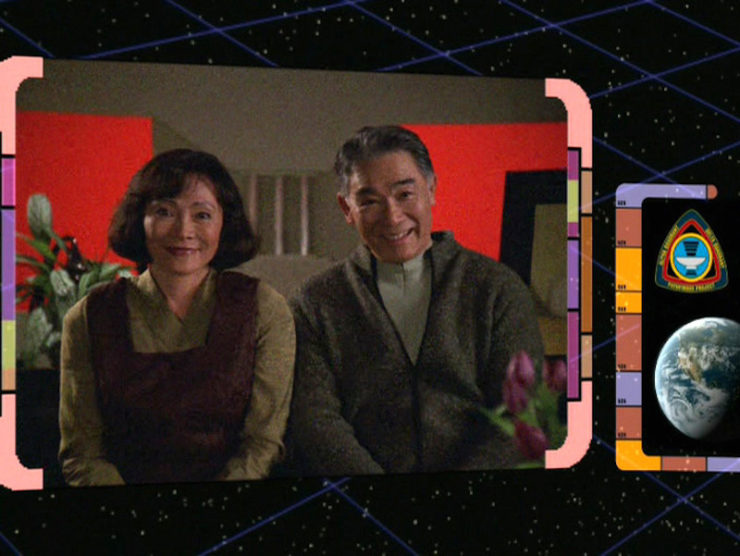
Forever an ensign. Kim gets to talk to his parents in time for his Mom’s birthday. His parents want to know why he hasn’t been promoted, especially given that he’s been in command of gamma shift, a question also on the minds of the viewers. Kim gives the bullshit answer about how there are limited opportunities on the ship, even though both Tuvok and Paris have been promoted without a problem…
Resistance is futile. Seven gets to meet her aunt, and discovers that her love of strawberries goes back to before she was assimilated, as she used to devour Irene Hansen’s strawberry tarts when she was six.
No sex, please, we’re Starfleet. In Photons, Be Free, Three of Eight is the only person who is nice to the EMH, and at one point she helps him escape from security’s clutches. Meanwhile, Marseilles uses sickbay for illicit liaisons with female crewmembers who aren’t his wife, sending the EMH on a wild goose chase to engineering to cover.
In Paris’ rewrite, the EMH is all over Two of Three, and in this version there are triplet ex-Borg, and the EMH always mixes One of Three, Two of Three, and Three of Three up.
Do it.
“I don’t mean to sound ungrateful, but it feels like a hollow victory. Pardon the pun.”
–The EMH feeling the effects of a pyrrhic victory and making a funny in the process.
Welcome aboard. Lots of returning guests in this one, some as the same character, some not. We’ve got Richard Herd as Owen and Dwight Schultz as Barclay, both last seen in “Inside Man,” and both of whom will next be seen in “Endgame.” We’ve got Juan Garcia as John Torres, last seen in “Lineage.” We’ve got Barry Gordon as Broht, last seen as a Ferengi in DS9’s “The Nagus,” and we’ve got Robert Ito as Kim’s Dad, last seen as Tac Officer Chang in TNG’s “Coming of Age.”
In addition, there’s Irene Tsu as Kim’s Mom, Lorinne Vozoff as Seven’s aunt, and the great Joseph Campanella as the arbitrator.
Plus most of the regulars play their holo-novel counterparts: Kate Mulgrew with different hair as Captain Jenkins, Robert Beltran with a ponytail and a different tattoo as First Officer Katanay, Roxann Dawson without cranial ridges as Chief Engineer Torrey, Robert Duncan McNeill with a mustache as Lieutenant Marseilles, Tim Russ with a goatee and normal ears as Security Chief Tulak, Jeri Ryan with different hair and wardrobe as both Three of Eight and Two of Three, and Garrett Wang with Trill spots as Ensign Kymble.
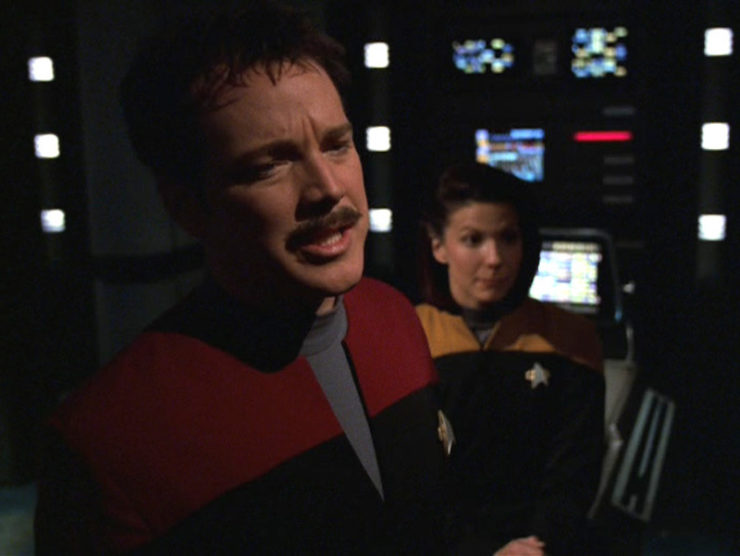
Trivial matters: Paris says that Broht & Forrester publishes the Dixon Hill mysteries, which are holo-novels favored by Captain Picard, as seen in “The Big Goodbye” and several other TNG episodes, as well as First Contact. Paris considers bringing the Captain Proton holo-stories to them to publish, which the EMH initially pooh-poohs, even though the Dixon Hill stories are homages to the same early-20th-century era of pulp storytelling.
The second half of the publisher’s name is probably a tribute to C.S. Forrester, the author of the Horatio Hornbower novels, which was one of Gene Roddenberry’s primary inspirations in the creation of Star Trek.
When testifying to the EMH’s sentience, the events of “One,” “Tinker Tenor Doctor Spy,” the “Workforce” two-parter, “Someone to Watch Over Me,” “Life Line,” and “Flesh and Blood” are referred to by Janeway, Kim, Seven, and Barclay.
Tulak, the nastier version of Tuvok, has a goatee, which is a tribute to Spock in the Mirror Universe also having a goatee in the original series’ “Mirror, Mirror.” (Later, the MU versions of both Ambassador Soval in Enterprise’s “In a Mirror, Darkly” two-parter and Ambassador Sarek in Discovery’s “The Wolf Inside” will have goatees, also.)
The EMH says that, as far as he knows, Janeway hasn’t executed any of his patients, which is actually not true, as she technically executed Tuvix…
That EMH Mark 1s had been repurposed to menial tasks was established in “Life Line.” The issue of holographic rights, and the EMH’s advocating for them, will also be seen in the novels Homecoming and The Farther Shore by Christie Golden.
Chakotay mentions that he is going to contact his sister, which is the first time this sibling has been mentioned. She appears, and is given the name Sekaya, in Golden’s novels Homecoming, Old Wounds, and Enemy of My Enemy.
This is Irene’s only on-screen appearance, but she is in Homecoming, as Seven chooses to live with her upon Voyager’s return to the Alpha Quadrant. Irene is said to be dying of Irumodic Syndrome in Destiny: Mere Mortals by David Mack, and the EMH attempts a cure in Unworthy by Kirsten Beyer, but is unsuccessful, and Irene dies in that novel. Irene was named after co-scripter Michael Sussman’s mother.
While Kim’s parents aren’t named in dialogue, the script gives them the first names of John and Mary. Yes, really. Why the scripters chose to give two of the vanishingly rare Asian characters in a Trek episode the two most generic white-person names in the world is left as an exercise for the viewer.
Torres says she and Paris are thinking of naming their daughter Miral, after Torres’ mother (who was seen, and established as being believed to be deceased, in “Barge of the Dead“). While their daughter’s given name won’t be established onscreen—not even when the child appears, both as a newborn and an adult, in “Endgame”—all the tie-in fiction (novels, comics, games) that has featured the Torres-Paris offspring has assumed she’d be named Miral.
Neelix’s proposal of a Delta Quadrant cookbook is especially amusing given that Ethan Phillips co-wrote The Star Trek Cookbook, in character as Neelix, in collaboration with William J. Birnes, which came out in January 1999, more than two years prior to this episode’s airing.
Neelix gives out 146 numbered isolinear chips, one for each member of the crew, though that presumably doesn’t count either Icheb or Neelix himself, so there are apparently 148 people on board. Hilariously, 146 is also the crew complement given in “Someone to Watch Over Me,” and they’ve actually added to the crew since then: Icheb and the five Equinox crew, though they’ve also lost a few (two or three in “Equinox, Part II” for starters). Whatever…
Finally, for some really trivial matters, this episode first aired on your humble rewatcher’s 32nd birthday.
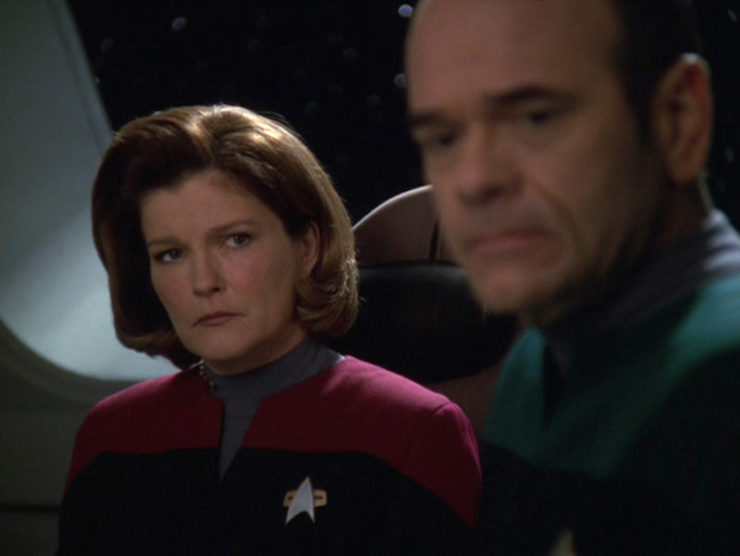
Set a course for home. “It’s just frustrating to be told I have no more legal standing than a replicator.” Parts of this episode are absolutely brilliant. For starters, every single person who has been an editor of science fiction novels for a publisher any time over the last five decades has a story about a submission they received: it’s a space opera taking place aboard the Starship Journey under the command of John Q. Kirkman, aided by his inscrutable alien first officer Mr. Sprake. When these novels are summarily rejected, the author often complains—as the EMH does here—that the characters are nothing like the trademarked characters owned by CBS/Paramount, how dare you accuse me of that????
Some aspects of Photons, Be Free, as well as Paris’ rewrite, provide some nice meta commentary on some of Voyager’s more problematic aspects. Jenkins shooting an unnamed, badly injured crew person so that the EMH can treat one of the “senior staff” for a mild concussion is a nasty riff on the fact that nobody seems to even notice when someone who isn’t in the opening credits dies, but it’s a major tragedy if any of the billed cast even gets hurt. It’s “Mortal Coil,” where Neelix gets the zombie Borg cure after he’s killed, which is never offered to any of the other folks on board who die, taken to its absurdist extreme. And then we have Marseilles’ womanizing ways and the comb-over version of the EMH drooling over the Borg triplets as a good satire on how creepy both Paris and the EMH have been over the years. And indeed, many of the crew treated the EMH poorly in the early going. (Of course, the one who always treated him like a person was Kes, and some acknowledgment of her role wouldn’t have been untoward here. Sigh. Three of Eight pretty much takes on the Kes role in Photons, Be Free.)
I also love that suddenly everyone wants to use the EMH’s in with Broht & Forrester to submit their holo-novel proposal, which is so very true to life…
And the running B-plot with the crew getting to talk to their families is very touching. It’s lovely to see the beginnings of a reconciliation between Torres père et fille, Kim’s conversation with his parents is an absolute delight (“Maybe I should write her?” “Mom!”), and Jeri Ryan plays her conversation with Aunt Irene with her usual subtlety, as for the first time Seven realizes that she actually has something to get home to in the Alpha Quadrant.
Having said all that, the episode has some serious problems, starting with the reason why the EMH wrote Photons, Be Free in the first place. For reasons passing understanding, they decided to run with the idiotic notion proposed in “Life Line” that EMH Mark 1’s are performing menial tasks in mines and such, which has never made anything like sense, and makes even less sense in this episode where we see them working with cudgels and pickaxes—in the 24th century! With its amazing technology! What the hell????? Any hope that this particular notion was an exaggeration provided by an ill Lewis Zimmerman is dashed in this episode, and the universe is poorer for it.
And then we retread old ground, as Voyager decides to do TNG’s “The Measure of a Man,” but without actually acknowledging that episode, which is especially idiotic given that the precedent of that episode establishing Data’s sentience is really important to Tuvok’s case to establish the EMH’s, and legal proceedings are all about precedent. And in the same way that Picard has been treating synths—artificial intelligences in artificial bodies—as something to be outlawed but holograms—AIs in photonic bodies—as something completely different, the inability to draw the line between Data and the EMH here is maddening. It’s not entirely the same thing, since most holograms aren’t sentient. Having said that, there has to be some kind of legal standing for those that are, like Moriarty, like the EMH, like Vic Fontaine. The episode dances around it but doesn’t quite bring it together (despite fine performances by Tim Russ back in the role of advocate and John Campanella as the arbitrator).
There’s enough good in this episode that I’m going ahead and giving it a high rating. The actual events of Photons, Be Free are hilarious (honestly, I’d bump it up to a 7 for Marseilles’ mustache alone…), the satire of both Voyager as a show and the authorial process throughout are beautiful, the conversations with loved ones are all sweet and touching and wonderful, and I especially like that the EMH’s victory isn’t absolute—his sentience is still up in the air, but at least he’s allowed to be considered an artist. (I also love that the Federation constitution apparently has a whole section about art and artists.)
But the whole holographic rights thing is unutterably stupid, and the episode should have acknowledged and worked with the TNG episode it was borrowing its plot from.
Warp factor rating: 7
Keith R.A. DeCandido’s most recent fiction includes the thriller Animal (written with Dr. Munish K. Batra) about a serial killer who targets people who harm animals; All-the-Way House, part of the Systema Paradoxa series of books about cryptids, telling the secret origin of the Jersey Devil; “Unguarded,” a story about guardian angels in two different faiths in the anthology Devilish and Divine; and “In Earth and Sky and Sea Strange Things There Be,” a story of H. Rider Haggard’s She, in the charity anthology Turning the Tied.










